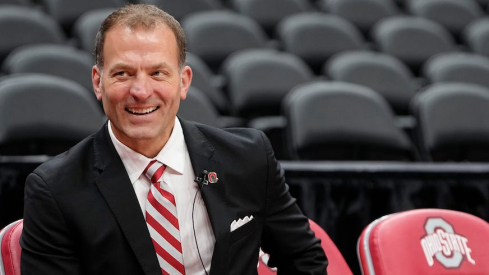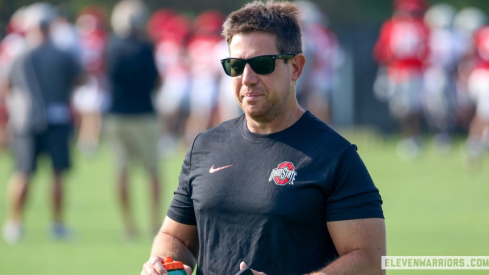The depth chart was released Monday which means we can almost taste the beginning of the season. It also means we tend to ramp up our expectations, whether they deal with personnel, coaches or offensive philosophy. It’s that latter part I want to focus on today.
During the Game of the Century three years ago, Brent Musberger called Jim Tressel the best playcaller he's seen in college football in a long time. It was lofty praise but there was good reason for it. Tressel had a cast of explosive offensive players who gave him the confidence to be more dynamic in his play selection. And, the result was an attack that worked all parts of the field and reduced predictability, all to the chagrin of opposing defensive coordinators.
It’s important to first point out what I mean by dynamic playcalling. I’m not suggesting passing every down or dialing up trickeration every series. In fact, I hate that type of football. It seems indentity-less. Rather, my idea involves using the middle of the field more, feeding the tight end, hitting running backs on screens and most of all, setting up defenses by running different plays from the same formation. I know it sounds like standard-fare stuff but we’ve largely been devoid of each one the last few years.
This element of deception brings two examples to mind immediately. The first came during the victory over Notre Dame in Fiesta Bowl where Tressel cleverly used a somewhat unusual bunch formation involving two tight ends and a WR. On the opposite side of the field, Ginn was split wide and Pittman was the lone running back. Ohio State ran out of this formation two or three times initially with modest results:

The Irish safeties started reading run based on previous plays and naturally started getting on their toes to crash the line of scrimmage. Unfortunately for them, that’s exactly what Tressel wanted to happen and he used Santonio Holmes to pay for their aggressiveness. Holmes was the wide receiver lined up with the bunch but rather than staying in to block, he released and ran right by the Notre Dame secondary to accept a perfectly thrown Troy Smith pass. The pre-snap formation, although now going in a different direction, is the exact same one the team rushed from earlier:

As good as that play was, it’s not even the best example in my opinion. The following year as Ohio State was walking through opponents, the staff installed a super jumbo look at Northwestern. This formation called for five lineman to the right of the center. Along side the extra tackle, the last two lineman are actually a tight end and receiver (Ginn).


We ran Beanie for the first down and a nice gain (left screenshot). The staff could easily have just snuck Troy for the first down or ran a stock I-Formation play but they saw an opportunity to setup Michigan for the following week (right screenshot). Although the down was different, the distance was the same and so was the formation. Certainly Michigan saw this during film study and knew we ran out of it previously. This time, however, Ginn released and darted upfield to the surprise of the Michigan defense. Had Smith’s pass not been underthrown slightly, he would have been untouched as he scored.
It’s been a while since we’ve seen that style from The Vest. Playcalling changes with each season as a natural ebb and flow occurs when players depart. What could be done one year, may not be possible the next. The coaches have varying degrees of confidence based on experience, talent and, in the case of the quarterback, mobility. When a team lacks more than one of those items, the staff tends to button up the offense to minimize risk. It’s sound football tactically but for those who wish for a more wide open attack, you’re left longing.
On the surface, it would seem this season will feature another year of a more conservative plan. Tressel has an offense that lacks experience in a major way, easily the most youthful two-deep I can remember. He also lost, as we know, his alpha-dog running back who simply moved the chains, provided flexibility and turned scary would-be tacklers into thumbsuckers. And, yet, here I believe the staff has all the reason to return to the dynamic playcalling we saw a few short years ago.
Terrelle Pryor is a once in a decade talent who, we’ve been told, has improved ten-fold and lives in the film room. It would be un-American to have him hand off, run the occasional boot and playaction all day. He also has a bevy of talented receivers who make up for their lack of experience with speed. In addition, the offensive line - although retooled - is thought to be a strength this year providing flexibility to open up more of the playbook. And as much as we have with Pryor, it is what we don’t have that also leads me to think we become more aggressive. Our grinder of a RB is gone and we have no experienced fullback - admittingly though, the fullback is going the way of the dodo bird.
By getting back to this more intelligent attack, pressure is returned to the defense. JT and staff purposely establish mini-tendencies and then break them within the same game. Sideline routes are no longer pounded into the ground because they now work between the hashes as much as outside them. We even saw this to a small degree last year in Wisconsin on Ohio State’s final drive. Of course, I don’t expect any of this to show itself against Navy. But, I would be disappointed if it didn’t materialize as the season progresses since it would help compensate for any deficiency likely magnified if the staff stuck to a conservative plan.

